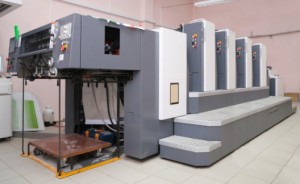There are a lot of things that need printing: brochures, catalogs, flyers, business cards—the list goes on. But did you ever think about what your best option might be, going digital or offset printing? There are a lot of differences, so when you find yourself in need of some printing, you may want to consider these factors before choosing a vendor to get the job done.
Offset presses require the design image to be first burned onto aluminum plates. After mounting the plate onto the press and adjusting for proper alignment, the image is transferred to a rubber sheet (blanket). The rubber blanket will then transfer the images to the paper through the application of different layers of ink. This is where the term “Offset” printing is derived from. The image to be printed on the plate obtains ink from the ink rollers while the blank area attracts a sheet of water, keeping it clean and ink free. This process requires a lot of time and preparation and is usually recommended for large volume printing jobs.

Offset printing allows for a choice to use the Pantone Matching System (PMS), which expands the color choices for your project. You can specify the shade of ink you want so you’ll be more satisfied with the outcome. (I should also add that finding a press room that will run spot colors is becoming increasingly difficult due to production and labor costs.) Gradients also tend to reproduce well and without banding or blotches. The other more popular method used in offset printing is the CMYK process model.
Based on the current offering for digital presses, the old thinking that output of offset printing presses tend to have higher quality is no longer a valid argument. However, the gamut (range of color) that an offset press can reproduce is still wider than most digital presses. The ability to reproduce a gradient is also better on the offset press. A quick proof from a digital press will allow you to make the decision as to the need to go offset for a short run or not.
Printing on various types of paper and material is easy through offset printing, no matter what color of paper you use. However, with offset printing, you can’t print on black paper since there are no white opaque ink options like we have with our digital press. With offset printing, you can also use a variety of papers with varying thickness and textures.
When printing in bulk, offset printing tends to be more budget friendly than digital printing. You may even be able to include your short run jobs in with a printer’s gang runs to save even more money on the small 250 or 500 run quantity jobs.
What makes the printing press costly is the various equipment needed to set up the machine and the number of operators needed to operate. Maintenance is also another thing to worry about. Overruns are sometimes charged to the customer and printing jobs may cost up to twice that of digital printing especially when you print in low quantities on a custom run.
When making revisions, stopping the presses is no easy task. After the revision, the production may be stalled, moving the date further out and pushing the costs even higher. This makes the proofing process that much more critical.
Aside from the exhausting set up time needed, the printing time and preparation of the materials make traditional offset printing a definite test of patience and purses.
Experience with color printers at home or at the office will give you the basic knowledge needed to understand the process of digital printing. The main difference between the two is the elimination of large machinery and time-consuming processes needed to start printing. With digital printing, all you need is your computer, printer, and paper and you’re good to go.
Print only what you need. A run of 50 or 100 brochures for a presentation or meeting is quick and easy. This can help cut the cost of your overall project. Digital printing is printed directly onto paper unlike traditional printing, which needs a lot of equipment and set up to operate.
The elimination of numerous equipment and set up steps makes digital printing a good alternative for time-stricken individuals. Most printing services guarantee fast service, ranging from 5 minutes to just a few days.
Since you can digitally edit your file, you can just stop the printing after the 1st proof is produced or print another batch without delaying your project for another week or accumulating a lot of costs. You can also customize each file and print them in batches like in variable data catalogs or postcards with a customized advertising message.
Digital printing typically uses the CMYK (cyan, magenta, yellow, and black) inks and are printed as tiny dots on the paper. Unlike offset printing which can use the Pantone colors, digital printers have a limited color range. This means they may not accurately reproduce extensive sets of colors. Different printer settings may also affect the outcome of printing. Gradients may pose a problem as well.
Digital printers have limited choices on paper types and textures. Some printers don’t have the capacity to print larger sizes of papers or print on thick materials or textured stocks.
Metallic inks are having limited succes for digital printers. Some services like foil stamping and embossing are rarely offered by digital printing houses.
For each project, there is a perfect printing method. It’s not about which is better than the other but rather which better suits the requirements for your project. SLB Printing can help you determine what method you should use and offer a wide variety of services for your printing needs. If you are looking for a reliable printing service in Los Angeles, look no further!